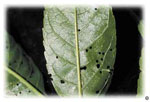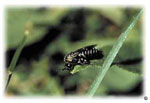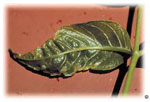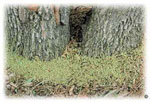
The brown-headed ash sawfly has spread along Colorado’s Front Range in recent years. The worms, or larvae, chew newly emerging ash leaves in May and early June. The good news is that sawflies are only out for a month every year and are relatively easy to control.
The larvae spend the winter in underground cocoons at the base of previously infested ash trees.  In the spring, they pupate and emerge as adult sawflies. The adults are small, non-stinging wasps that come out on sunny days shortly after bud break. They quickly mate and lay eggs on young leaves.
In the spring, they pupate and emerge as adult sawflies. The adults are small, non-stinging wasps that come out on sunny days shortly after bud break. They quickly mate and lay eggs on young leaves.
The eggs hatch and feed, producing tiny holes within the leaves. As the larvae grow, they chew whole leaf sections and even whole leaves, leaving only the tough leaf veins.  A large infestation can defoliate a tree. Damage will diminish rapidly within two to three weeks after eggs hatch and the larvae become full-grown. By mid-June, they drop and burrow into the ground where they will remain until emerging the following spring.
A large infestation can defoliate a tree. Damage will diminish rapidly within two to three weeks after eggs hatch and the larvae become full-grown. By mid-June, they drop and burrow into the ground where they will remain until emerging the following spring.
Sawflies are easily controlled, even if infestations are severe. The key is to make timely pesticide applications in late-May when sawfly larvae are still small.  A strong jet of water knocks many off of trees, preventing more damage. Insecticidal soap sprays also kill larvae. Most garden insecticides also are effective, except Bt type sprays.
A strong jet of water knocks many off of trees, preventing more damage. Insecticidal soap sprays also kill larvae. Most garden insecticides also are effective, except Bt type sprays.
For more information, see the following Colorado State University Extension fact sheet(s).



